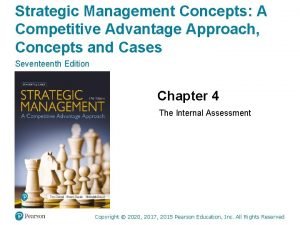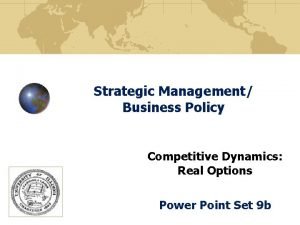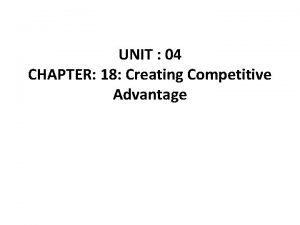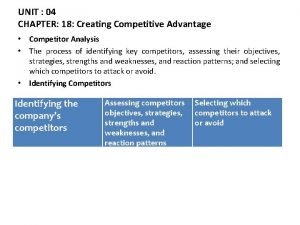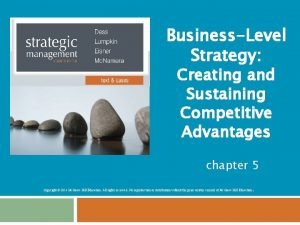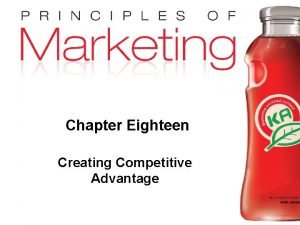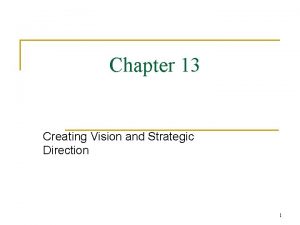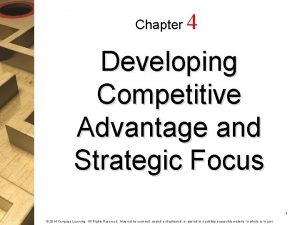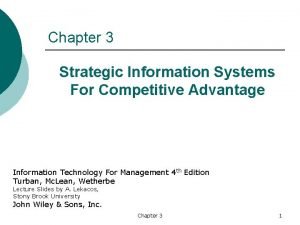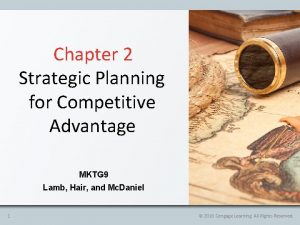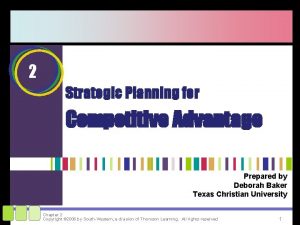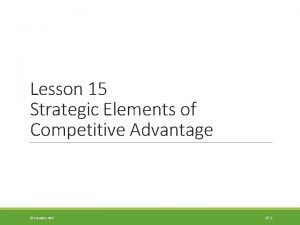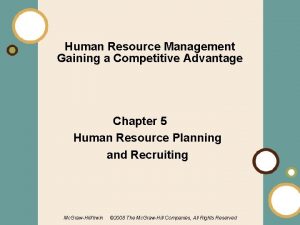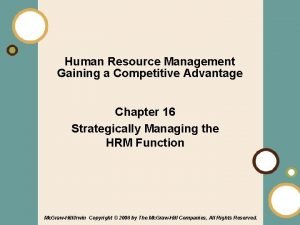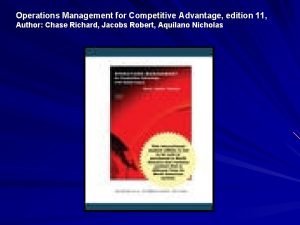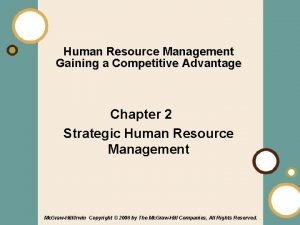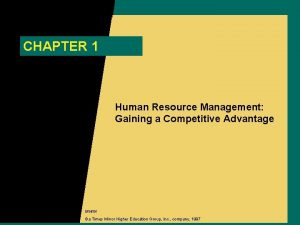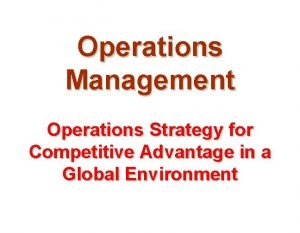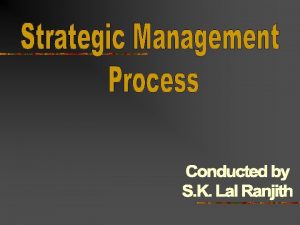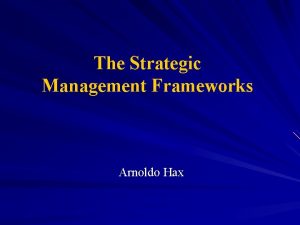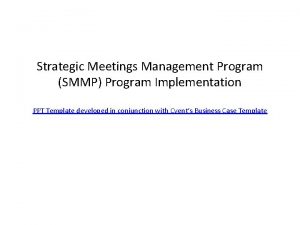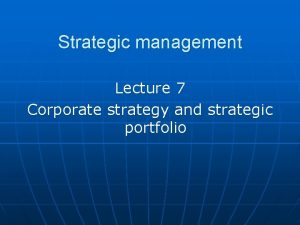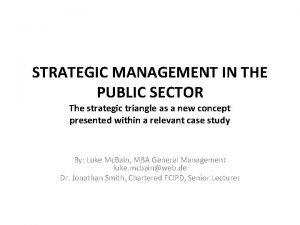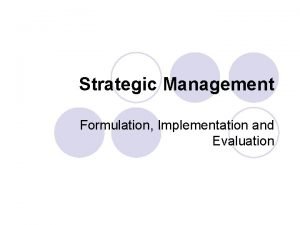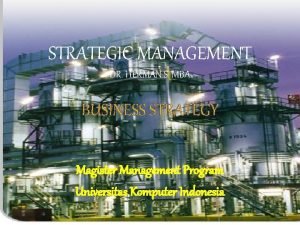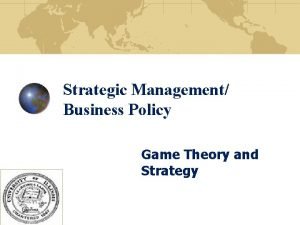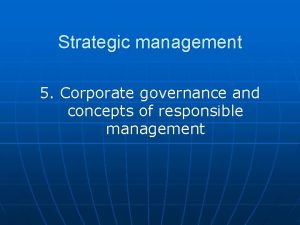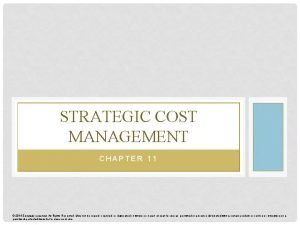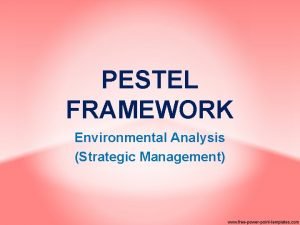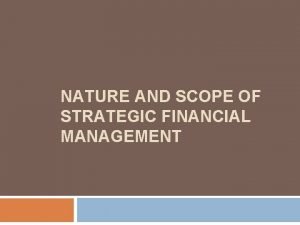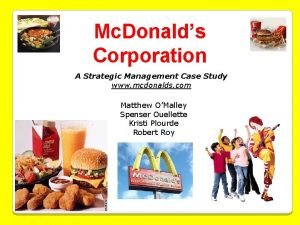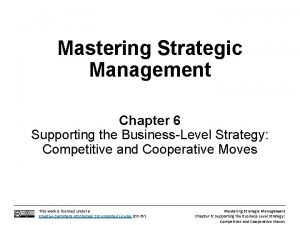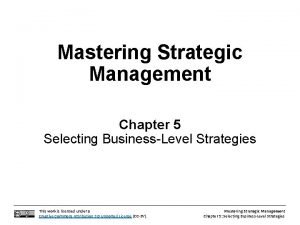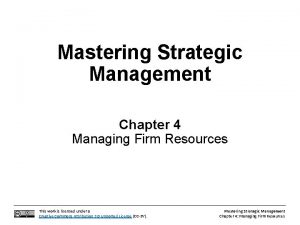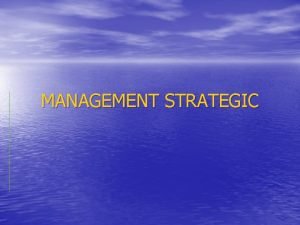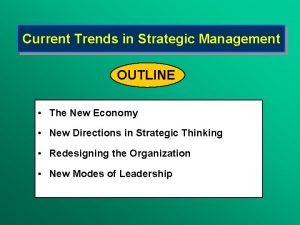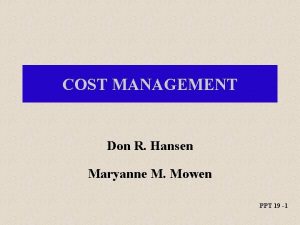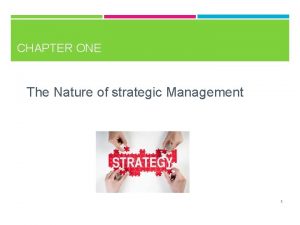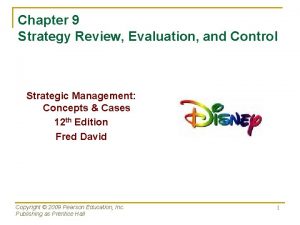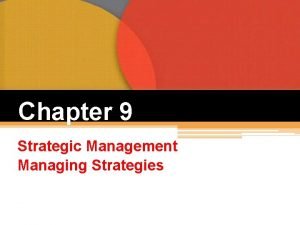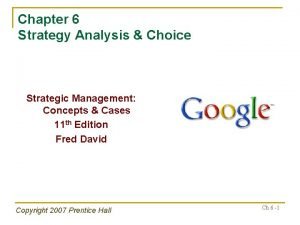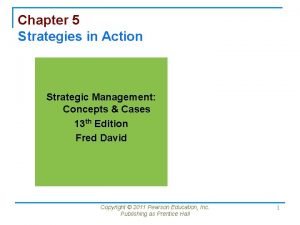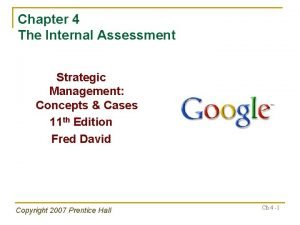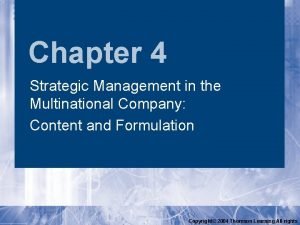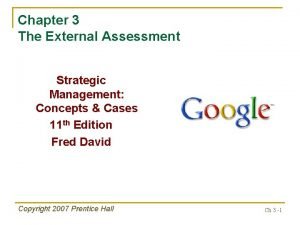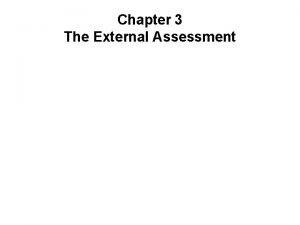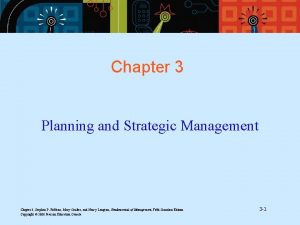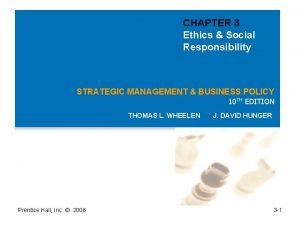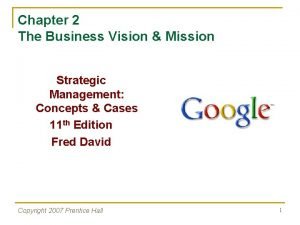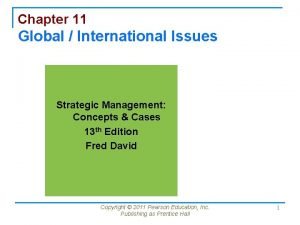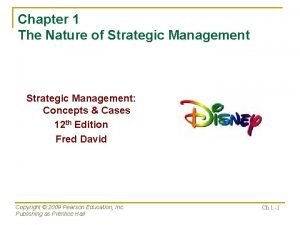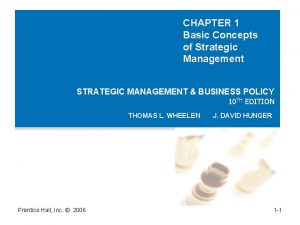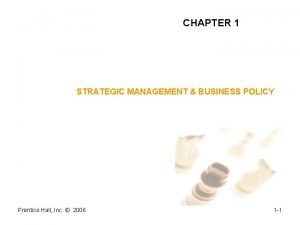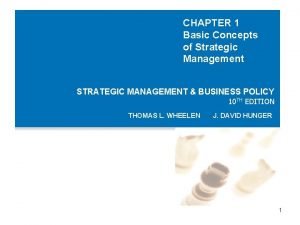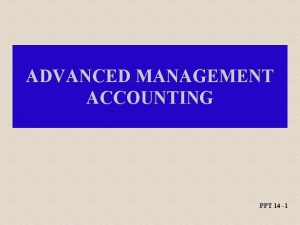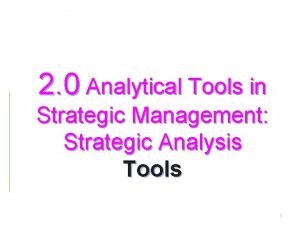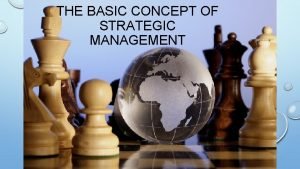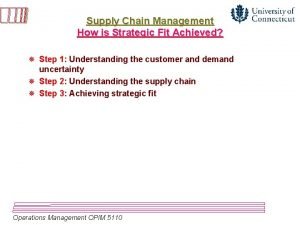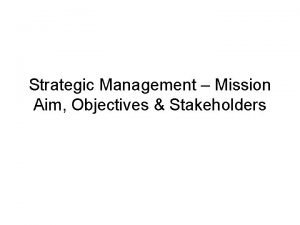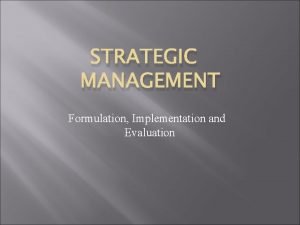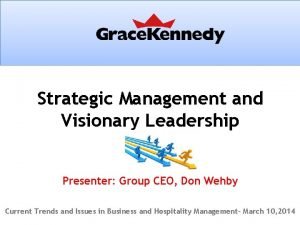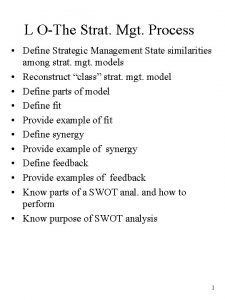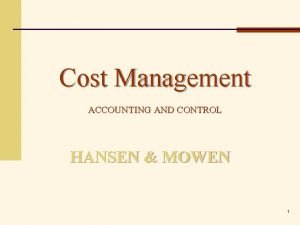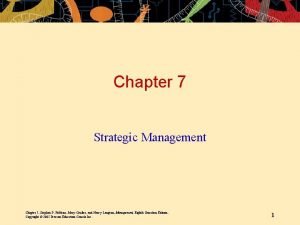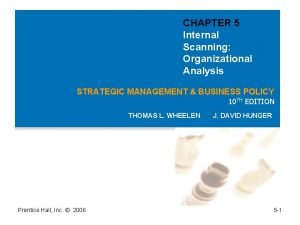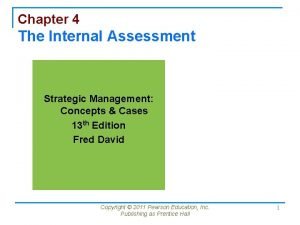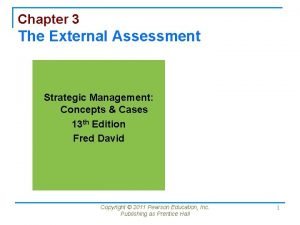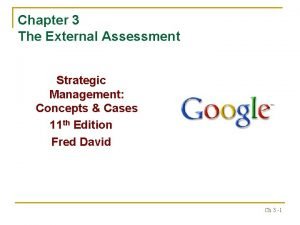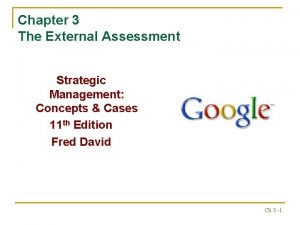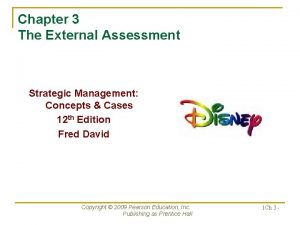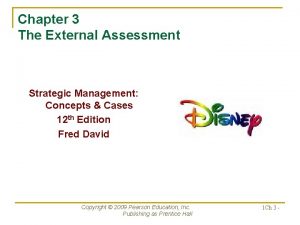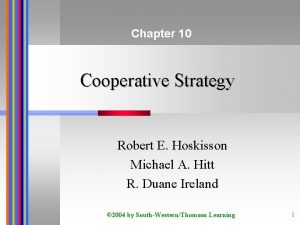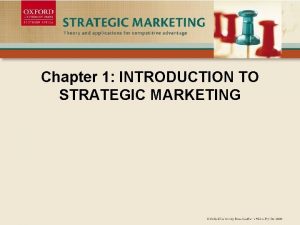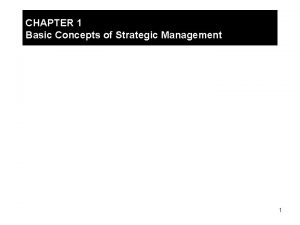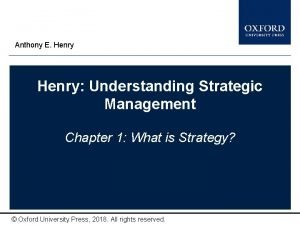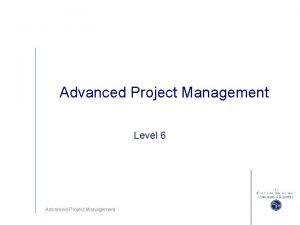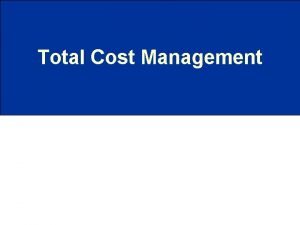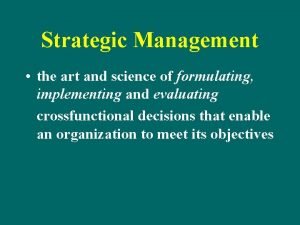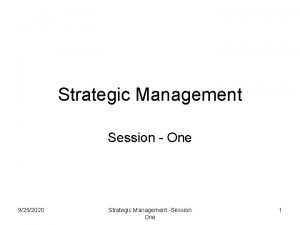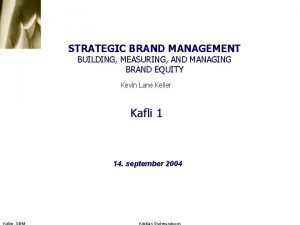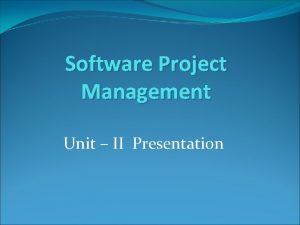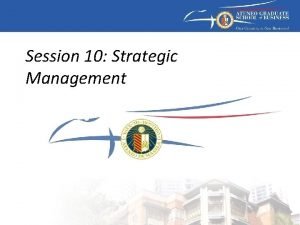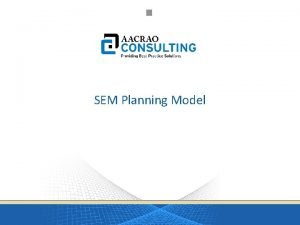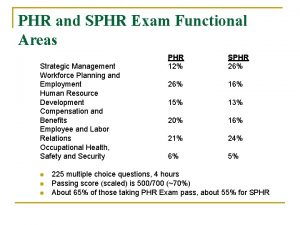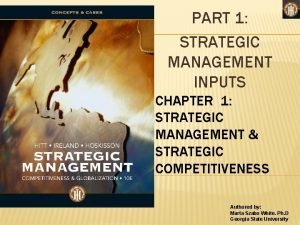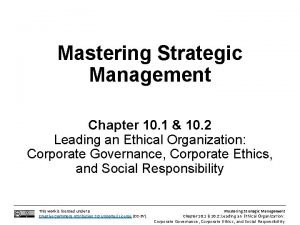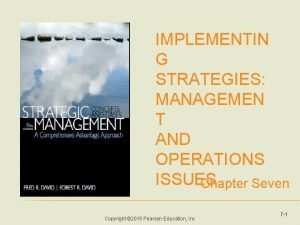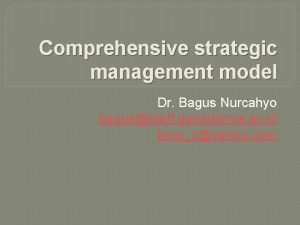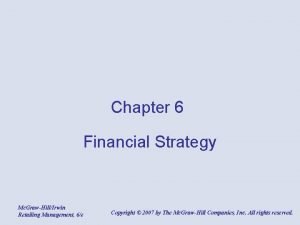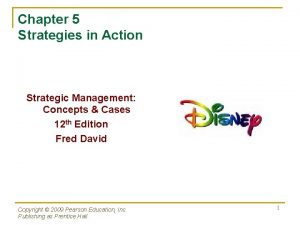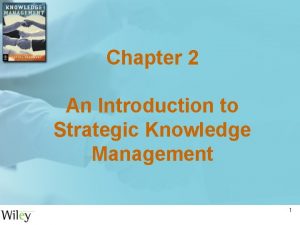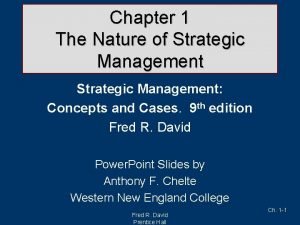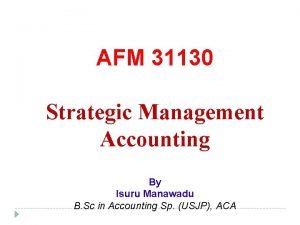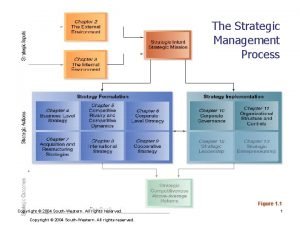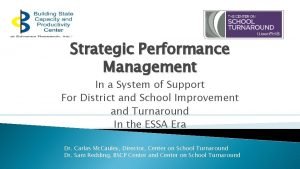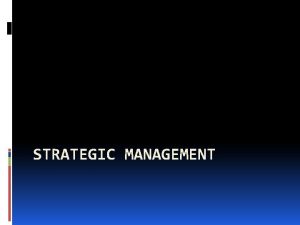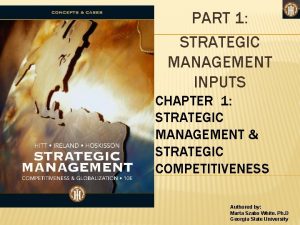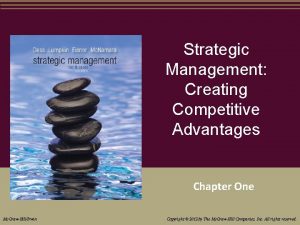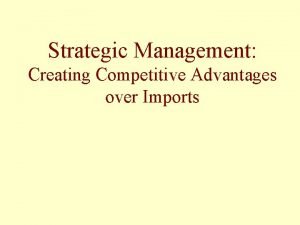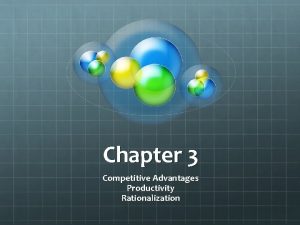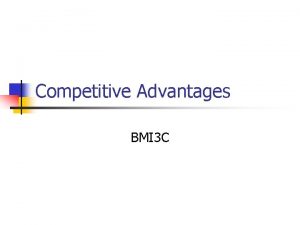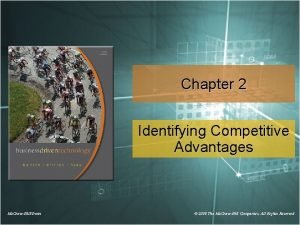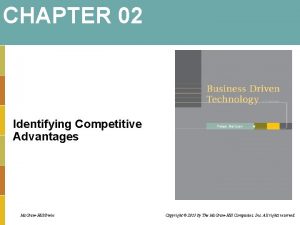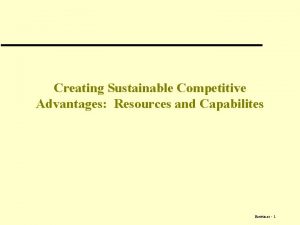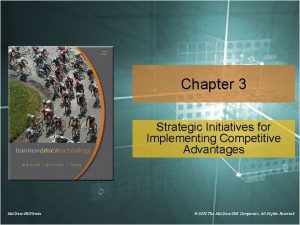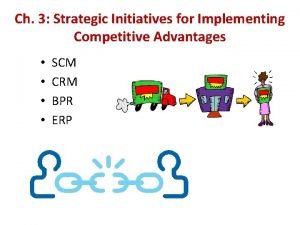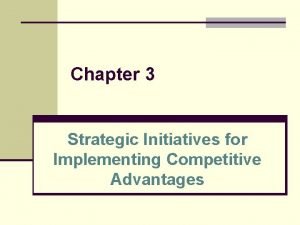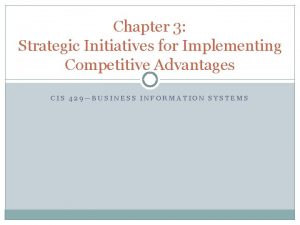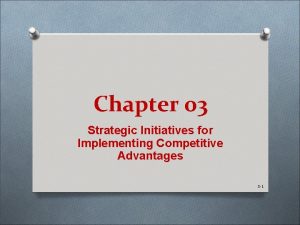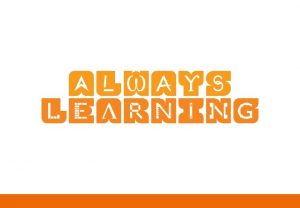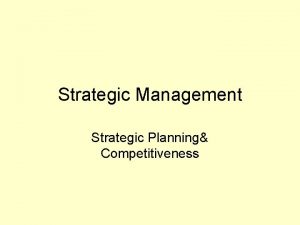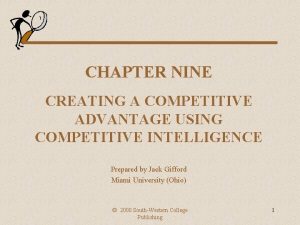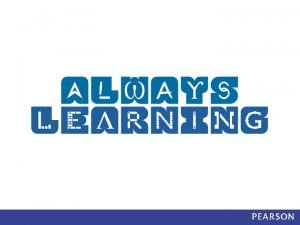1 Strategic Management Creating Competitive Advantages Mc GrawHillIrwin


















































































































































- Slides: 146


1 Strategic Management: Creating Competitive Advantages Mc. Graw-Hill/Irwin Strategic Management: Text and Cases, 4 e Copyright © 2008 The Mc. Graw-Hill Companies, Inc. All rights reserved.

1 -3 Learning Objectives After reading this chapter, you should have a good understanding of: § The definition of strategic management and its four key attributes. § The strategic management process and its three interrelated and principal activities. § The vital role of corporate governance and stakeholder management as well as how “symbiosis” can be achieved among an organization’s stakeholders. § The importance of social responsibility, including environmental sustainability, and how it can enhance a corporation’s innovation strategy. § The need for greater empowerment throughout the organization. § How an awareness of a hierarchy of strategic goals can help an organization achieve coherence in its strategic direction.

1 -4 Two Perspectives of Leadership • Romantic view ‾ • Leader is the key force in organization’s success External control perspective ‾ • Focus is on external factors that affect an organization’s success Leaders can make a difference ‾ ‾ Must be aware of opportunities and threats faced in external environment Must have thorough understanding of the firm’s resources and capabilities

1 -5 Strategic Management • Analysis • Strategic decisions • Actions • Strategic management is the study of why some firms outperform others

1 -6 Strategic Management Process Adapted from Exhibit 1. 2 Realized Strategy and Intended Strategy: Usually Not the Same Source: H. Mintzberg and J. A. Waters, “Of Strategies, Deliberate and Emergent, ” Strategic Management Journal 6 (1985), pp. 25772.

1 -7 Strategic Analysis • Starting point in the strategic management process • Precedes effective formulation and implementation of strategies

1 -8 Strategic Analysis (cont. ) • Clear goals and objectives permit effective allocation of resources • Hierarchy of goals - Vision - Mission - Strategic objectives • Analyzing external environments - Managers must scan the environment and analyze competitors - General environment - Industry environment

1 -9 Coherence in Strategic Direction Company vision Mission statements Strategic objectives Hierarchy of Goals

1 - 10 Strategy Formulation • Business level strategy • Corporate-level strategy • International Strategy • Effective strategies for entrepreneurial initiatives

1 - 11 Strategy Implementation • Informational control • Behavioral control • Effective corporate governance • Organizational structure and design • Organizational boundaries • Strategic Alliances • Develop organization that is committed to ethical behavior

1 - 12 Corporate Governance and Stakeholder Management • Corporate governance: the relationship among various participants in determining the direction and performance of corporations - Shareholders - Management (led by the CEO) - Board of Directors

1 - 13 Stakeholder Management • Two views of stakeholder management - Zero sum • Stakeholders compete for attention and resources of the organization • Gain of one is a loss to the other - Symbiosis • Stakeholders are dependent upon each other • Mutual benefits

1 - 14 Social Responsibility • Social responsibility: the expectation that businesses or individuals will strive to improve the overall welfare of society ‾ Managers must take active steps to make society better ‾ Socially responsible behavior changes over time ‾ Triple bottom line

1 - 15 Strategic Management Perspective • Integrative view of the organization • Assess how functional areas and activities “fit together” to achieve goals and objectives • All managers and employees must take and integrative, strategic perspective of issues facing the organization

2 Analyzing the External Environment of the Firm Mc. Graw-Hill/Irwin Strategic Management: Text and Cases, 4 e Copyright © 2008 The Mc. Graw-Hill Companies, Inc. All rights reserved.

1 - 17 Learning Objectives After reading this chapter, you should have a good understanding of: - The importance of developing forecasts of the business environment. Why environmental scanning, environmental monitoring, and collecting competitive intelligence are critical inputs to forecasting. Why scenario planning is a useful technique for firms competing in industries characterized by unpredictability and change. The impact of the general environment on a firm’s strategies and performance.

1 - 18 Learning Objectives • After reading this chapter, you should have a good understanding of: - How forces in the competitive environment can affect profitability and how a firm can improve its competitive position by increasing its power vis-à-vis these forces. How trends and events in the general environment and forces in the competitive environment are interrelated and affect performance. How the intranet and digitally based compatibilities are affecting the five competitive forces and industry profitability. The concept of strategic groups and their strategy and performance implications.

1 - 19 Creating the Environmentally Aware Organization

1 - 20 Environmental Scanning & Monitoring • External Scanning - Surveillance of a firm’s external environment: • Predict environmental changes to come • Detect changes already under way • Proactive mode • External Monitoring - Track evolution of: • Environmental trends • Sequence of events • Streams of activities

1 - 21 Competitive Intelligence • Define and understand a firm’s industry • Identify rivals’ strengths and weaknesses - Intelligence gathering (data) - Interpretation of intelligence data • Helps a firm avoid surprises

1 - 22 Environmental Forecasting • Plausible projections about - Direction of environmental change Scope of environmental change Speed of environmental change Intensity of environmental change • Scenario analysis

1 - 23 SWOT Analysis • Managers need to analyze - The general environment - The firm’s industry and competitive advantage • SWOT analysis - Strengths Weaknesses Opportunities Threats Basic technique for analyzing firm and industry condition

1 - 24 The General Environment • Segments of the general environment include: - Demographic Socio-cultural Legal/Political Technological Economic Global • General environmental trends and events: - Little ability to predict them - Even less ability to control them - Can vary across industries General Environmen t

1 - 25 The Competitive Environment • Segments of the competitive environment include: - Competitors - Customers - Suppliers • Sometimes called the task or industry environment • Porter’s five forces model Competitive Environment

1 - 26 Porter’s Five Forces Model of Industry Competition

1 - 27 Using Industry Analyses: A Few Caveats • Five Forces analysis implicitly assumes a zero-sum game • Five Forces analysis is essentially a static analysis - Value net • Suppliers and customers (the vertical net) • Substitutes and complements (the horizontal net)

1 - 28 The Value Net

1 - 29 Strategic Groups within Industries • Two unassailable assumptions in industry analysis - No two firms are totally different - No two firms are exactly the same • Strategic groups • Cluster of firms that share similar strategies - Breadth of product and geographic scope Price/quality Degree of vertical integration Type of distribution system

1 - 30 Strategic Groups within Industries • Value of strategic groups as an analytical tool - Identify barriers to mobility that protect a group from attacks by other groups - Identify groups whose competitive position may be marginal or tenuous - Chart the future direction of firms’ strategies - Thinking through the implications of each industry trend for the strategic group as a whole

3 Assessing the Internal Environment of the Firm Mc. Graw-Hill/Irwin Strategic Management: Text and Cases, 4 e Copyright © 2008 The Mc. Graw-Hill Companies, Inc. All rights reserved.

1 - 32 Learning Objectives • After reading this chapter, you should have a good understanding of: - - The benefits and limitations of SWOT analysis in conducting an internal analysis of the firm. The primary and support activities of a firm’s value chain. How value-chain analysis can help managers create value by investigating relationships among activities within the firm and between the firm and its customers and suppliers. The resource-based view of the firm and the different types of tangible and intangible resources, as well as organizational capabilities.

1 - 33 Learning Objectives • After reading this chapter, you should have a good understanding of: - - The four criteria that a firm’s resources must possess to maintain a sustainable advantage and how value created can be appropriated by employees. The usefulness of financial ratio analysis, its inherent limitations, and how to make meaningful comparisons of performance across firms. The value of recognizing how the interests of a variety of stakeholders can be interrelated. How firms are using Internet technologies to add value and achieve unique advantages. (Appendix)

1 - 34 The Limitations of SWOT Analysis • Strengths may not lead to an advantage • SWOT’s focus on the external environment is too narrow • SWOT gives a one-shot view of a moving target • SWOT overemphasizes a single dimension of strategy

1 - 35 Value-Chain Analysis • Sequential process of value-creating activities • The amount that buyers are willing to pay for what a firm provides them • Value is measured by total revenue • Firm is profitable to the extent the value it receives exceeds the total costs involved in creating its product or service

1 - 36 The Value Chain Adapted from Exhibit 3. 1 The Value Chain: Primary and Support Activities Source: Adapted with permission of The Free Press, a division of Simon & Schuster, Inc. , from Competitive Advantage: Creating and Sustaining Superior Performance by Michael E. Porter.

1 - 37 Interrelationships among Value-Chain Activities within and across Organizations • Importance of relationships among value activities - Interrelationships among activities within the firm - Relationships among activities within the firm and with other organization (e. g. , customers and suppliers)

1 - 38 Resource-Based View of the Firm • Two perspectives - The internal analysis of phenomena within a company - An external analysis of the industry and its competitive environment • Three key types of resources - Tangible resources - Intangible resources - Organizational capabilities

1 - 39 Evaluating Firm Performance • Two approaches for evaluating firm performance - Financial ratio analysis • Balance sheet • Income statement - Balanced scorecard (stakeholder perspective) • Employees • Customers • Owners

1 - 40 Financial Ratio Analysis • Five types of financial ratios - Short-term solvency or liquidity Long-term solvency measures Asset management (or turnover) Profitability Market value • Meaningful ratio analysis must include - Analysis of how ratios change over time - How ratios are interrelated

1 - 41 The Balance Scorecard • Provides a meaningful integration of many issues that come into evaluating a firm’s performance • Four key perspectives - How do customers see us? (customer perspective) - What must we excel at? (internal perspective) - Can we continue to improve and create value? (innovation and learning perspective) - How do we look to shareholders? (financial perspective)

1 - 42 Potential Limitations of the Balanced Scorecard • Lack of a clear strategy • Limited or ineffective executive sponsorship • Too much emphasis on financial measures rather than nonfinancial measures • Poor data on actual performance • Inappropriate links to scorecard measures to compensation • Inconsistent or inappropriate Terminology

4 Recognizing a Firm’s Intellectual Assets: Moving beyond a Firm’s Tangible Resources Mc. Graw-Hill/Irwin Strategic Management: Text and Cases, 4 e Copyright © 2008 The Mc. Graw-Hill Companies, Inc. All rights reserved.

1 - 44 Learning Objectives • After reading this chapter, you should have a good understanding of: - Why the management of knowledge professionals and knowledge itself are so critical in today’s organizations. The importance of recognizing the interdependence of attracting, developing and retaining human capital. The key role of social capital in leveraging human capital within and across the firm. The importance of social networks in knowledge management and in promoting career success. Why teams are critical in combining and leveraging knowledge in organizations and how they can be made more effective.

1 - 45 Learning Objectives • After reading this chapter, you should have a good understanding of: - The vital role of technology in leveraging knowledge and human capital. How technology can help to retain knowledge even when employees cannot be retained by the organization. The challenge of protecting intellectual property and the importance of a firm’s dynamic capabilities. How leveraging human capital is critical to strategy formulation at the business, corporate, international, and Internet levels.

1 - 46 The Central Role of Knowledge in Today’s Economy • Creation of wealth in a knowledge economy - Effective management of knowledge workers - Intellectual capital - Assets such as • • • Reputation Employee loyalty and commitment Customer relationships Company values Brand names Experience and skills of employees

1 - 47 The Central Role of Knowledge in Today’s Economy Intellectual capital = Market value of the firm – Book value of the firm • How do companies create value in the knowledgeintensive economy? - Human capital (individual capabilities, knowledge, skills, and experience of the company’s employees and managers) - Social capital (the network of relationships that individuals have throughout the organization) - Knowledge • Explicit knowledge • Tacit knowledge

1 - 48 Human Capital: The Foundation of Intellectual Capital Exhibit 4. 2 Human Capital: Three Interdependent Activities

1 - 49 Enhancing Human Capital: How Diversity Benefits the Organization 1. 2. 3. 4. 5. 6. Cost argument Resource acquisition argument Marketing argument Creativity argument Problem-solving argument System flexibility argument

1 - 50 How Social Capital Helps Attract and Retain Talent • Hiring via personal (social) networks - Some job candidates may bring other talent with them - Emigration of talent from an organization to form start-up ventures - Can provide mechanism for obtaining resources and information from outside the organization

1 - 51 The Potential Downside of Social Capital • Groupthink • Cost of financial resources • Managerial commitment

1 - 52 Knowledge of Social Networks • Implications that an understanding of social networks has on one’s career - Closure - Bridging relationships • From an individual’s perspective, social networks deliver three unique advantages - Private information - Access to diverse skill sets - Power

1 - 53 Using Technology to Leverage Human Capital and Knowledge • Sharing knowledge and information • Technology can leverage human capital and knowledge • Using networks to share information and develop products and services • Codifying knowledge for competitive advantage

1 - 54 The Central Role of Leveraging Human Capital in Strategy Formulation • Leveraging human capital and business-level strategy (Chapter 5) - Sustainable over time • Integrate primary and support activities in the firm’s value chain • Leveraging human capital and corporate-level strategy (Chapter 6) - Manage businesses to create synergy - Create more value by working together across business units

1 - 55 The Central Role of Leveraging Human Capital in Strategy Formulation • Leveraging human capital and international-level strategy (Chapter 7) - Achieve economies of scale - Adapt to local market needs - Facilitate the flow of information and knowledge between business units in different countries

1 - 56 The Central Role of Leveraging Human Capital in Strategy Formulation • Leveraging human capital and entrepreneurial strategies (Chapter 8) - Create value through technology Lower costs Enhance customer service Improve performance

5 Business-Level Strategy Mc. Graw-Hill/Irwin Strategic Management: Text and Cases, 4 e Copyright © 2008 The Mc. Graw-Hill Companies, Inc. All rights reserved.

1 - 58 Learning Objectives • After reading this chapter, you should have a good understanding of: - - The central role of competitive advantage in the study of strategic management. The three generic strategies: overall cost leadership, differentiation, and focus. How the successful attainment of generic strategies can improve a firm’s relative power vis-à-vis the five forces that determine an industry’s average profitability. The pitfalls managers must avoid in striving to attain generic strategies. How firms can effectively combine the generic strategies of overall cost leadership and differentiation.

1 - 59 Learning Objectives • After reading this chapter, you should have a good understanding of: - - How Internet-enabled business models are being used to improve strategic positioning. The importance of considering the industry life cycle to determine a firm’s business-level strategy and its relative emphasis on functional area strategies and value-creating activities. The need for turnaround strategies that enable a firm to reposition its competitive position in an industry.

1 - 60 Types of Competitive Advantage and Sustainability • Three generic strategies to overcome the five forces and achieve competitive advantage - Overall cost leadership • Low-cost-position relative to a firm’s peers • Manage relationships throughout the entire value chain - Differentiation • Create products and/or services that are unique and valued • Non-price attributes for which customers will pay a premium - Focus strategy • Narrow product lines, buyer segments, or targeted geographic markets • Attain advantages either through differentiation or cost leadership

1 - 61 Three Generic Strategies Exhibit 5. 1 Three Generic Strategies Source: Reprinted with permission of The Free Press, a division of Simon & Schuster, Inc. , from Competitive Strategy: Techniques for Analyzing Industries and Competitors by Michael E. Porter. Copyright © 1980, 1998 by The Free Press.

1 - 62 Overall Cost Leadership • Integrated tactics - Aggressive construction of efficient-scale facilities Vigorous pursuit of cost reductions from experience Tight cost and overhead control Avoidance of marginal customer accounts Cost minimization in all activities in the firm’s value chain, such as R&D, service, sales force, and advertising

1 - 63 Overall Cost Leadership (Cont. ) • A firm following an overall cost leadership position - Must attain parity on the basis of differentiation relative to competitors - Parity on the basis of differentiation • Permits a cost leader to translate cost advantages directly into higher profits than competitors • Allows firm to earn above-average profits

1 - 64 Differentiation • Differentiation can take many forms - Prestige or brand image Technology Innovation Features Customer service Dealer network

1 - 65 Differentiation • Firms may differentiate along several dimensions at once • Firms achieve and sustain differentiation and aboveaverage profits when price premiums exceed extra costs of being unique • Successful differentiation requires integration with all parts of a firm’s value chain • An important aspect of differentiation is speed or quick response

1 - 66 Focus • Focus is based on the choice of a narrow competitive scope within an industry - Firm selects a segment or group of segments (niche) and tailors its strategy to serve them - Firm achieves competitive advantages by dedicating itself to these segments exclusively • Two variants - Cost focus - Differentiation focus

1 - 67 Three Combination Approaches • Automated and flexible manufacturing systems • Exploiting the profit pool concept for competitive advantage • Coordinating the “extended” value chain by way of information technology

1 - 68 Industry Life-Cycle States: Strategic Implications • Life cycle of an industry - Introduction Growth Maturity Decline • Emphasis on strategies, functional areas, valuecreating activities, and overall objectives varies over the course of an industry life cycle

6 Corporate-Level Strategy: Creating Value through Diversification Mc. Graw-Hill/Irwin Strategic Management: Text and Cases, 4 e Copyright © 2008 The Mc. Graw-Hill Companies, Inc. All rights reserved.

1 - 70 Learning Objectives • After reading this chapter, you should have a good understanding of: - - - How managers can create value through diversification initiatives. The reasons for the failure of many diversification efforts. How corporations can use related diversification to achieve synergistic benefits through economies of scope and market power. How corporations can use unrelated diversification to attain synergistic benefits trough corporate restructuring, parenting, and portfolio analysis. The various means of engaging in diversification-mergers and acquisitions, joint ventures/strategic alliances, and internal development. Managerial behaviors that can erode the creation of value.

1 - 71 Making Diversification Work • Diversification initiatives must create value for shareholders - Mergers and acquisitions Strategic alliances Joint ventures Internal development • Diversification should create synergy Business 1 Business 2

1 - 72 Synergy • Related businesses (horizontal relationships) - Sharing tangible resources - Sharing intangible resources • Unrelated businesses (hierarchical relationships) - Value creation derives from corporate office - Leveraging support activities

1 - 73 Creating Value Related Diversification: Economies of Scope Leveraging core competencies • 3 M leverages it competencies in adhesives technologies to many industries, including automotive, construction, and telecommunications Sharing activities • Mc. Kesson, a large distribution company, sells many product lines, such as pharmaceuticals and liquor, through its superwarehouses Related Diversification: Market Power Pooled negotiating power Ø The Times Mirror Company increases its power over customers by providing “one-stop shopping” for advertisers to reach customers through multiple media —television and newspapers—in several huge markets such as New York and Chicago Vertical integration Ø Shaw industries, a giant carpet manufacturer, increases its control over raw materials by producing much of its own polypropylene fiber, a key input to its manufacturing process Exhibit 6. 2 Creating Value through Related and Unrelated Diversification

1 - 74 Unrelated Diversification: Financial Synergies and Parenting • Most benefits from unrelated diversification are gained from vertical (hierarchical) relationships - Parenting and restructuring of businesses - Allocate resources to optimize - Profitability - Cash flow - Growth - Appropriate human resources practices - Financial controls

1 - 75 Corporate Parenting & Restructuring • Corporate Parenting - Parenting—creating value within business units • Experience of the corporate office • Support of the corporate office • Corporate Restructuring - Find poorly performing firms • With unrealized potential • On threshold of significant positive change

1 - 76 Corporate Restructuring (Cont. ) • Corporate management must - Have insight to detect undervalued companies or businesses with high potential for transformation - Have requisite skills and resources to turn the businesses around • Restructuring can involve changes in - Assets - Capital structure - Management

1 - 77 Means to Achieve Diversification • Acquisitions or mergers • Pooling resources of other companies with a firm’s own resource base - Joint venture - Strategic alliance • Internal development - New products - New markets - New technology

1 - 78 Strategic Alliances and Joint Ventures • Introduce successful product or service into a new market - Lacks requisite marketing expertise • Doesn’t understand customer needs • Doesn’t know how to promote the product • Doesn’t have access to proper distribution channels • Join other firms to reduce manufacturing (or other) costs in the value chain - Pool capital - Pool value-creating activities - Pool facilities

1 - 79 Strategic Alliances and Joint Ventures • Develop or diffuse new technologies - Use expertise of two or more companies - Develop products technologically beyond the capability of the companies acting independently

1 - 80 Unmet Expectations: Strategic Alliances and Joint Ventures • Improper partner - Each partner must bring desired complementary strengths to partnership - Strengths contributed by each should be unique • Partners must be compatible • Partners must trust one another

7 International Strategy: Creating Value in Global Markets Mc. Graw-Hill/Irwin Strategic Management: Text and Cases, 4 e Copyright © 2008 The Mc. Graw-Hill Companies, Inc. All rights reserved.

1 - 82 Learning Objectives • After reading this chapter, you should have a good understanding of: - - - The importance of international expansion as a viable diversification strategy. The sources of national advantage, that is, why an industry in a given country is more (or less) successful than the same industry in another country. The motivations (or benefits) and the risks associated with international expansion, including the emerging trend for greater offshoring and outsourcing activity. The two opposing forces—cost reduction and adaptation to local markets—that firms face when entering international markets.

1 - 83 Learning Objectives • After reading this chapter, you should have a good understanding of: - - The advantages and disadvantages associated with each of the four basic strategies: international, global, multidomestic, and transnational. The difference between regional companies and truly global companies. The four basic types of entry strategies and the relative benefits and risks associated with each of them.

1 - 84 The Global Economy: A Brief Overview • Opportunities and risks when firms diversify abroad - Trade across nations will exceed trade within nations - Rise of market capitalism around the world - Transfer of money from rich to poor countries • Equity • Bond Investments • Commercial loans

1 - 85 The Global Economy: A Brief Overview • Opportunities and risks when firms diversify abroad - Economies of East Asia have grown rapidly, but little progress in the rest of the world - Poor education levels in many countries - Failure to manage broader economic factors in some countries • Interest rates • Inflation • Unemployment

1 - 86 Factors Affecting a Nation’s Competitiveness • Factor conditions - Nation’s position in factors of production • Skilled labor • Infrastructure • Demand conditions - Nature of home-market demand • Industry’s product • Industry’s service

1 - 87 Factors Affecting a Nation’s Competitiveness • Related and supporting industries - Presence or absence in the nation of internationally competitive • Supplier industries • Other related industries • Firm strategy, structure, and rivalry - Conditions in the nation governing how companies are • Created • Organized • Managed - Nature of domestic rivalry

1 - 88 A Company’s Motivation for International Expansion • Increase the size of potential markets • Attain economies of scale • Reducing the costs of R&D as well as operating costs • Extend the life cycle of a product • Optimize the physical location for every activity in its value chain - Performance enhancement - Cost reduction - Risk reduction

1 - 89 Potential Risks of International Expansion • Political and economic risk - Social unrest Military turmoil Demonstrations Violent conflicts and terrorism Laws and their enforcement

1 - 90 Potential Risks of International Expansion • Currency risks - Currency exchange fluctuations - Appreciation of the U. S. dollar • Management risks - Culture Customs Language Income levels Customer preferences Distribution system

1 - 91 Outsourcing and Offshoring • Outsourcing occurs when a firm decides to utilize other firms to perform value-creating activities that were previously performed inhouse. • Offshoring takes place when a firm decides to shift an activity that they were previously performing in a domestic location to a foreign location.

1 - 92 Two Opposing Pressures: Reducing Costs and Adapting to Local Markets • Strategies that favor global products and brands - Should standardize all of a firm’s products for all of their worldwide markets - Should reduce a firm’s overall costs by spreading investments over a larger market - Are based on three assumptions • Customer needs and interests worldwide are becoming more homogeneous • People (worldwide) prefer lower prices at high quality • Economies of scale in production and marketing can be achieved through supplying global markets

1 - 93 Entry Modes of International Expansion Adapted from Exhibit 7. 10 Entry Modes for International Expansion

8 Entrepreneurial Strategy and Competitive Dynamics Mc. Graw-Hill/Irwin Strategic Management: Text and Cases, 4 e Copyright © 2008 The Mc. Graw-Hill Companies, Inc. All rights reserved.

1 - 95 Learning Objectives • After reading this chapter, you should have a good understanding of: - The role of opportunities, resources, and entrepreneurs in successfully pursuing new ventures. The role of new ventures and small businesses in the U. S. economy. Three types of entry strategies—pioneering, initiative, and adaptive—commonly used to launch a new venture. How the generic strategies of overall cost leadership, differentiation, and focus are used by new ventures and small businesses.

1 - 96 Learning Objectives • After reading this chapter, you should have a good understanding of: - - How competitive actions, such as the entry of new competitors into a marketplace, may launch a cycle of actions and reactions among close competitors. The components of competitive dynamics analysis—new competitive action , threat analysis, motivation and capability to respond, types of competitive actions, and likelihood of competitive reaction.

1 - 97 Recognizing Entrepreneurial Opportunities • Entrepreneurship – new value creation • New value can be created in: - Start-up ventures Major corporations Family-owned businesses Non-profit organizations Established institutions

1 - 98 Opportunity Analysis Framework Adapted from Exhibit 8. 2 Opportunity Analysis Framework Sources: Based on J. A. Timmons and S. Spinelli, New Venture Creation, 6 th ed. (Burr Ridge, IL: Mc. Graw-Hill/Irwin, 2004); and W. D. Bygrave, “The Entrepreneurial Process, ” in W. D. Bygrave, ed. , The Portable MBA in Entrepreneurship, 2 nd ed. (New York: Wiley, 1997).

1 - 99 Entrepreneurial Opportunities • Opportunities come from many sources - Start-ups • • • Current or past work experiences Hobbies that grow into businesses or lead to inventions Suggestions by friends or family Chance events Change

1 - 100 Entrepreneurial Opportunities • Opportunities come from many sources - Established firms • • Needs of existing customers Suggestions by suppliers Technological developments that lead to new advances Change

1 - 101 Opportunity Recognition Process • Discovery phase - Period when you first become aware of a new business concept - May be spontaneous and unexpected - May occur as the result of deliberate search for • New venture projects • Creative solutions to business problems

1 - 102 Opportunity Recognition Process • Opportunity formation phase - Evaluating an opportunity (Can it be developed into a fullfledged new venture? ) • Talk to potential target customers • Discuss it with production or logistics managers • Conduct feasibility analysis - Market potential Product concept testing Focus groups Trial runs with end users

1 - 103 Characteristics of Good Opportunities Good Business Opportunity Attractive Achievable Value creating Durable Before launching opportunity as a business • Evaluate readiness and skills of entrepreneurial founder or team • Consider availability and access to resources

1 - 104 Entry Strategies • Getting a foothold in the market - Pioneering new entry • Creating new ways to solve old problems • Meeting customer’s needs in a unique new way - Imitative new entry • Strong marketing orientation • Introduce same basic product or service in another segment of the market

1 - 105 Entry Strategies • Getting a foothold in the market - Adaptive new entry • Offer product or service that is “somewhat new and different” • Aware of marketplace conditions and conceive entry strategies to capitalized on current trends

1 - 106 Generic Strategies • How new ventures can achieve competitive advantages - Overall cost leadership • Simple organizational structures • More quickly upgrade technology and integrate feedback from the marketplace • Make timely decisions that affect cost - Differentiation • Use new technology • Deploy resources in a radical new way - Focus • Niche strategies fit the small business mold

1 - 107 Combination Strategies • A key issue is the scope of a small firm’s strategic efforts relative to those of its competitors - Pursue combination strategies • Combine best features of low-cost, differentiation, and focus strategies • Flexibility and quick decision-making ability of a small firm not laden with layers of bureaucracy

1 - 108 Model of Competitive Dynamics Sources: Adapted from Chen, M-J. 1996. Competitor analysis and interfirm rivalry: Toward a theoretical integration. Academy of Management Review, 21(1): 100 -134; Ketchen, D. J. , Snow, C. C. , Hoover, V. L. 2004. Research on competitive dynamics: Recent accomplishments and future challenges. Journal of Management, 30(6): 779 -804; and Smith, K. G. , Ferrier, W. J. , & Grimm, C. M. 2001. King of the hill: Dethroning the industry leader. Academy of Management Executive, 15(2): 59 -70.

9 Strategic Control and Corporate Governance Mc. Graw-Hill/Irwin Strategic Management: Text and Cases, 4 e Copyright © 2008 The Mc. Graw-Hill Companies, Inc. All rights reserved.

1 - 110 Learning Objectives • After reading this chapter, you should have a good understanding of: - The value of effective strategic control systems in strategy implementation. The key difference between “traditional” and “contemporary” control systems. The imperative for “contemporary” control systems in today’s complex and rapidly changing competitive and general environments. The benefits of having the proper balance among the three levers of behavioral control: culture, rewards and incentives, and boundaries. The three key participants in corporate governance: shareholders, management (led by the CEO), and the board of directors. The role of corporate governance mechanisms in ensuring that the interests of managers are aligned with those of shareholders from both the United States and international perspectives.

1 - 111 Ensuring Informational Control • Traditional control system - Based largely on the feedback approach - Little or no action taken to revise strategies, goals and objectives until the end of the time period • Contemporary control system - Continually monitoring the environments (internal and external) - Identifying trends and events that signal the need to revise strategies, goals and objectives

1 - 112 Traditional Approach to Strategic Control • Traditional approach is sequential - Strategies are formulated and top management sets goals - Strategies are implemented - Performance is measured against the predetermined goal set - Control is based on a feedback loop from performance measurement to strategy formulation Adapted from Exhibit 9. 1 Traditional Approach to Strategic Control

1 - 113 Traditional Approach to Strategic Control • Process typically involves lengthy time lags, often tied to the annual planning cycle • This “single-loop” learning control system simply compares actual performance to a predetermined goal • Most appropriate when - Environment is stable and relatively simple - Goals and objectives can be measured with certainty - Little need for complex measures of performance

1 - 114 Contemporary Approach to Strategic Control • Relationships between strategy formulation, implementation and control are highly interactive • Two different types of control - Informational control - Behavioral control Adapted from Exhibit 9. 2 Contemporary Approach to Strategic Control

1 - 115 Informational Control • Traditional approach - Understanding of the assumption base is an initial step in the process of strategy formulation • Contemporary approach - Information control is part of an ongoing process of organizational learning that updates and challenges the assumptions underlying the firm’s strategy

1 - 116 Behavioral Control • Behavioral control is focused on implementation— doing things right • Three key control “levers” - Culture - Rewards - Boundaries

1 - 117 Behavioral Control: Balancing Culture, Rewards, and Boundaries • Traditional approach -Emphasizes comparing outcomes to predetermined strategies and fixed rules Adapted from Exhibit 9. 3 Essential Elements of Strategic Control • Contemporary approach - A balance between • Culture • Rewards • Boundaries

1 - 118 Building a Strong and Effective Culture • Effective culture must be - Cultivated - Encouraged - Fertilized • Maintaining an effective culture - Storytelling - Rallies or pep talks by top executives

1 - 119 Motivating with Rewards and Incentives • Rewards and incentive systems - Powerful means of influencing an organization’s culture Focuses efforts on high-priority tasks Motivates individual and collective task performance Can be an effective motivator and control mechanism

1 - 120 Setting Boundaries and Constraints • Focus efforts on strategic priorities • Short-term objectives - Specific and measurable Specific time horizon for attainment Achievable, but challenging Provide proper direction, but be flexible when faced with need to change

1 - 121 Role of Corporate Governance • Corporate governance - Relationship among • The shareholders • The management (led by the Chief Executive Officer) • The board of directors • Issue is - How corporations can succeed (or fail) in aligning managerial motives with • The interests of the shareholders • The interests of the board of directors

10 Creating Effective Organizational Designs Mc. Graw-Hill/Irwin Strategic Management: Text and Cases, 4 e Copyright © 2008 The Mc. Graw-Hill Companies, Inc. All rights reserved.

1 - 123 Learning Objectives • After reading this chapter, you should have a good understanding of: - The importance of organizational structure and the concept of the “boundaryless” organization in implementing strategies. The growth patterns of major corporations and the relationship between a firm’s strategy and its structure. Each of the traditional types of organizational structure: simple, functional, divisional, and matrix The relative advantages and disadvantages of traditional organizational structure The implications of a firm’s international operations for organizational structure

1 - 124 Learning Objectives • After reading this chapter, you should have a good understanding of: - - - Why there is no “one best way” to design strategic reward and evaluation systems, and the important contingent roles of businessand corporate-level strategies. The different types of boundaryless organizations—barrier-free, modular, and virtual—and their relative advantages and disadvantages The need for creating ambidextrous organizational designs that enable firms to explore new opportunities and effectively integrate existing operations

1 - 125 Traditional Forms of Organizational Structure • Organizational structure refers to formalized patterns of interactions that link a firm’s - Tasks - Technologies - People • Structure provides a means of balancing two conflicting forces - Need for the division of tasks into meaningful groupings - Need to integrate the groupings for efficiency and effectiveness

1 - 126 Patterns of Growth of Large Corporations • Simple Structure • Simple structure is the oldest and most common organizational form - Staff serve as an extension of the top executive’s personality Highly informal Coordination of tasks by direct supervision Decision making is highly centralized Little specialization of tasks, few rules and regulations, informal evaluation and reward system

1 - 127 Patterns of Growth of Large Corporations • Functional Structure Adapted from Exhibit 10. 2 Functional Organizational Structure

1 - 128 Divisional Structure Adapted from Exhibit 10. 3 Divisional Organizational Structure

1 - 129 Divisional Structure • Organized around products, projects, or markets • Each division includes its own functional specialists typically organized into departments • Divisions are relatively autonomous and consist of products and services that are different from those of other divisions • Division executives help determine product-market and financial objectives

1 - 130 Matrix Structure Adapted from Exhibit 10. 4 Matrix Organizational Structure

1 - 131 Matrix Structure • A combination of the functional and divisional structures • Individuals who work in a matrix organization become responsible to two managers - The project manager - The functional area manager

11 Strategic Leadership: Creating a Learning Organization and an Ethical Organization Mc. Graw-Hill/Irwin Strategic Management: Text and Cases, 4 e Copyright © 2009 The Mc. Graw-Hill Companies, Inc. All rights reserved.

1 - 133 Learning Objectives • After reading this chapter, you should have a good understanding of: - - The three key activities in which all successful leaders must be continually engaged. The importance of recognizing the interdependence of the three key leadership activities, and the salience of power in overcoming resistance to change. The crucial role of emotional intelligence (EI) in successful leadership as well as its potential drawbacks. The value of creating and maintaining a “learning organization” in today’s global marketplace.

1 - 134 Learning Objectives • After reading this chapter, you should have a good understanding of: - The five central elements of a “learning organization. ” The leader’s role in establishing an ethical organization. The benefits of developing an ethical organization. The high financial and nonfinancial costs associated with ethical crises.

1 - 135 Leadership: Three Interdependent Activities • Leadership is the process of transforming organizations from what they are to what the leader would have them become • Leadership should be - Proactive - Goal-oriented - Focused on the creation and implementation of a creative vision

1 - 136 Leadership: Three Interdependent Activities Successful leaders must recognize three interdependent activities: Adapted from Exhibit 11. 1 Three Interdependent Activities of Leadership

1 - 137 A Leader’s Bases of Power Exhibit 11. 2 A Leader’s Bases of Power

1 - 138 Emotional Intelligence: A Key Leadership Trait Successful traits of leaders at the highest level Technical skills Cognitive abilities Accounting, business planning, etc. Analytical reasoning, quantitative analysis, etc. Emotional intelligence Ability to work with others, passion for work, etc.

1 - 139 Emotional Intelligence • Five components of emotional intelligence - Self-awareness Self-regulation Motivation Empathy Social skill

1 - 140 Developing a Learning Organization • Successful learning organizations - Create a proactive, creative approach to the unknown - Actively solicit the involvement of employees at all levels - Enable all employees to use their intelligence and apply their imagination • Learning environment - Organization-wide commitment to change An action orientation Applicable tools and methods Guiding philosophy Inspired and motivated people with a purpose

1 - 141 Key Elements of a Learning Organization

1 - 142 Key Elements of Highly Ethical Organizations • These interrelated elements must be present and constantly reinforced - Role models Corporate credos and codes of conduct Reward and evaluation systems Policies and procedures

1 - 143 Key Elements of Highly Ethical Organizations • Role Models - Leaders are role models for their organizations - Leaders must be consistent in their words and deeds - Values and character of leaders become transparent to an organization’s employees - Effective leaders take responsibility for ethical lapses within the organization

1 - 144 Key Elements of Highly Ethical Organizations • Corporate credos and codes of conduct - Provide a statement and guidelines for norms, beliefs and decision making - Provide employees with clear understanding of the organizations position regarding employee behavior - Provide the basis for employees to refuse to commit unethical acts - Contents of credos and codes of conduct must be known to employees

1 - 145 Key Elements of Highly Ethical Organizations • Reward and evaluation systems - Inappropriate reward systems may cause individuals at all levels of the organization to commit unethical acts that they might not otherwise do - Penalties in terms of damage to reputations, human capital erosion, and financial loss are typically much higher than any gains that could be obtained through such unethical behavior

1 - 146 Key Elements of Highly Ethical Organizations • Policies and procedures - Policies and procedures can specify proper relationships with a firm’s customers and suppliers - Policies and procedures can guide employees to behavior ethically - Policies and procedures must be reinforced • • Effective communication Enforcement Monitoring Sound corporate governance practices
 Strategic management a competitive advantage approach
Strategic management a competitive advantage approach Dynamics
Dynamics Value creation strategy
Value creation strategy Chapter 18 creating competitive advantage
Chapter 18 creating competitive advantage Porters 3 generic strategy
Porters 3 generic strategy Chapter 18 creating competitive advantage
Chapter 18 creating competitive advantage Chapter 18 creating competitive advantage
Chapter 18 creating competitive advantage What is the least competitive market structure
What is the least competitive market structure Pharmacology introduction
Pharmacology introduction Standard cycle market example
Standard cycle market example Strategic management and strategic competitiveness
Strategic management and strategic competitiveness Strategic analysis and choice in strategic management
Strategic analysis and choice in strategic management Vision focuses on the current reality and maintaining it
Vision focuses on the current reality and maintaining it Competitive intelligence professional certification
Competitive intelligence professional certification Developing a firm's strategy canvas focuses on
Developing a firm's strategy canvas focuses on Dream box
Dream box Chapter 2 strategic planning for competitive advantage
Chapter 2 strategic planning for competitive advantage Strategic information system for competitive advantage
Strategic information system for competitive advantage Strategic planning for competitive advantage
Strategic planning for competitive advantage Strategic planning for competitive advantage
Strategic planning for competitive advantage Strategic elements of competitive advantage
Strategic elements of competitive advantage Strategic fit vs strategic intent
Strategic fit vs strategic intent Tirole
Tirole Human resources management gaining a competitive advantage
Human resources management gaining a competitive advantage Human resource management gaining a competitive advantage
Human resource management gaining a competitive advantage Human resource management gaining a competitive advantage
Human resource management gaining a competitive advantage Operations management for competitive advantage
Operations management for competitive advantage Human resource management: gaining a competitive advantage
Human resource management: gaining a competitive advantage Competitive manufacturing management
Competitive manufacturing management One way linkage hrm
One way linkage hrm Operations management for competitive advantage
Operations management for competitive advantage Human resource management gaining a competitive advantage
Human resource management gaining a competitive advantage Strategic alliance advantages
Strategic alliance advantages Top management and middle management
Top management and middle management Management pyramid
Management pyramid Middle level management
Middle level management Five tasks of strategic management
Five tasks of strategic management Strategic management frameworks
Strategic management frameworks Crafting and executing strategy in strategic management
Crafting and executing strategy in strategic management Balanced scorecard as a strategic management system
Balanced scorecard as a strategic management system Functional strategy in strategic management
Functional strategy in strategic management Strategic meeting management programs
Strategic meeting management programs What is corporate strategy in strategic management
What is corporate strategy in strategic management Strategic management in public sector
Strategic management in public sector Formality in strategic management
Formality in strategic management Sfas analysis example
Sfas analysis example Strategic management lecture
Strategic management lecture Dominant vs dominated strategy
Dominant vs dominated strategy Corporate governance chain
Corporate governance chain Importance of strategic management
Importance of strategic management Process of strategic cost management
Process of strategic cost management Ethics in strategic management
Ethics in strategic management Steepv framework
Steepv framework Strategic financial management outlook is in nature
Strategic financial management outlook is in nature Mcdonalds ife matrix
Mcdonalds ife matrix Strategic management chapter 6
Strategic management chapter 6 Strategic management chapter 5
Strategic management chapter 5 Strategic management chapter 4
Strategic management chapter 4 Managementul strategic
Managementul strategic A retailer must develop
A retailer must develop Emergent-strategy-definition
Emergent-strategy-definition Global international issues in strategic management
Global international issues in strategic management Indikator keberhasilan manajemen strategi
Indikator keberhasilan manajemen strategi Current trends in strategic management
Current trends in strategic management Strategic cost management hansen and mowen
Strategic cost management hansen and mowen Strategic management chapter 1
Strategic management chapter 1 Rumelt's criteria of consonance
Rumelt's criteria of consonance Strategic management chapter 9
Strategic management chapter 9 Captive company strategy
Captive company strategy Chapter 7 strategic management
Chapter 7 strategic management Implementing strategies management and operations issues
Implementing strategies management and operations issues Implementing strategies: management and operations issues
Implementing strategies: management and operations issues What are the two external dimensions of the space matrix?
What are the two external dimensions of the space matrix? Strategies in action in strategic management
Strategies in action in strategic management Integrating strategy and culture in internal assessment
Integrating strategy and culture in internal assessment Strategic management in multinational companies
Strategic management in multinational companies What is external assessment in strategic management
What is external assessment in strategic management The external assessment of strategic management
The external assessment of strategic management Strategic management chapter 3
Strategic management chapter 3 Social responsibility and ethics in strategic management
Social responsibility and ethics in strategic management Vision mission slide
Vision mission slide Staggered board structure
Staggered board structure Global international issues in strategic management
Global international issues in strategic management Strategic management benefits
Strategic management benefits Basic concepts of strategic management
Basic concepts of strategic management Basic concepts of strategic management
Basic concepts of strategic management Basic concept of strategic management
Basic concept of strategic management Change management interventions
Change management interventions Zara case study strategic management
Zara case study strategic management Management accounting ppt
Management accounting ppt Nicholls mission & core competencies
Nicholls mission & core competencies Contemporary strategic management
Contemporary strategic management Strategic compulsions
Strategic compulsions Pre master strategic management tilburg
Pre master strategic management tilburg Basic concept of strategic management
Basic concept of strategic management Strategic fit supply chain
Strategic fit supply chain Objectives of strategic management
Objectives of strategic management Strategy evaluation course
Strategy evaluation course Visionary leadership and strategic management
Visionary leadership and strategic management Steering control in strategic management
Steering control in strategic management Definition of strategic management
Definition of strategic management Strategic cost management hansen and mowen
Strategic cost management hansen and mowen Strategic management chapter 7
Strategic management chapter 7 Implement strategies management issues
Implement strategies management issues Scanning functional resources and capabilities
Scanning functional resources and capabilities The internal assessment strategic management
The internal assessment strategic management External strategic management audit
External strategic management audit Internal and external assessment in strategic management
Internal and external assessment in strategic management Cpm matrix
Cpm matrix Internal and external assessment in strategic management
Internal and external assessment in strategic management Internal and external assessment in strategic management
Internal and external assessment in strategic management External audit strategic management
External audit strategic management Corporate level cooperative strategy
Corporate level cooperative strategy Introduction to strategic marketing
Introduction to strategic marketing Basic concepts of strategic management
Basic concepts of strategic management Understanding strategic management
Understanding strategic management Project context
Project context What is strategic planning
What is strategic planning Strategic cost management procurement
Strategic cost management procurement Strategic management model
Strategic management model What can be defined as the art and science of formulating
What can be defined as the art and science of formulating Industrial organization (i/o) model
Industrial organization (i/o) model Incremental approach in strategic management
Incremental approach in strategic management Brand management process.
Brand management process. Strategic assessment in software project management
Strategic assessment in software project management Intensive strategies in strategic management
Intensive strategies in strategic management Strategic enrolment management
Strategic enrolment management Functional areas of strategic management
Functional areas of strategic management Strategic management inputs
Strategic management inputs Strategic management chapter 10
Strategic management chapter 10 Fraftfoods
Fraftfoods Matching structure with strategy
Matching structure with strategy A comprehensive strategic-management model
A comprehensive strategic-management model Strategic profit model in retail management
Strategic profit model in retail management Why is not advisable to pursue too many strategies at once
Why is not advisable to pursue too many strategies at once 5 ps of strategic knowledge management
5 ps of strategic knowledge management Vertical integration
Vertical integration Nature of strategic management
Nature of strategic management Strategic cost management chapter 1
Strategic cost management chapter 1 Isuru manawadu
Isuru manawadu Pillars of strategic management
Pillars of strategic management Multidivisional structure disadvantages
Multidivisional structure disadvantages Strategic management process
Strategic management process Strategic management performance system
Strategic management performance system Disney strategic management
Disney strategic management Software project evaluation
Software project evaluation Strategic management inputs
Strategic management inputs
